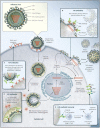Optimal Use of Vaccines for Control of Influenza A Virus in Swine
- PMID: 26344946
- PMCID: PMC4494241
- DOI: 10.3390/vaccines3010022
Optimal Use of Vaccines for Control of Influenza A Virus in Swine
Abstract
Influenza A virus in swine (IAV-S) is one of the most important infectious disease agents of swine in North America. In addition to the economic burden of IAV-S to the swine industry, the zoonotic potential of IAV-S sometimes leads to serious public health concerns. Adjuvanted, inactivated vaccines have been licensed in the United States for over 20 years, and there is also widespread usage of autogenous/custom IAV-S vaccines. Vaccination induces neutralizing antibodies and protection against infection with very similar strains. However, IAV-S strains are so diverse and prone to mutation that these vaccines often have disappointing efficacy in the field. This scientific review was developed to help veterinarians and others to identify the best available IAV-S vaccine for a particular infected herd. We describe key principles of IAV-S structure and replication, protective immunity, currently available vaccines, and vaccine technologies that show promise for the future. We discuss strategies to optimize the use of available IAV-S vaccines, based on information gathered from modern diagnostics and surveillance programs. Improvements in IAV-S immunization strategies, in both the short term and long term, will benefit swine health and productivity and potentially reduce risks to public health.
Keywords: immune response; influenza A virus in swine; surveillance; vaccines; veterinary diagnostics.
Figures




Similar articles
-
Comparison of Adjuvanted-Whole Inactivated Virus and Live-Attenuated Virus Vaccines against Challenge with Contemporary, Antigenically Distinct H3N2 Influenza A Viruses.J Virol. 2018 Oct 29;92(22):e01323-18. doi: 10.1128/JVI.01323-18. Print 2018 Nov 15. J Virol. 2018. PMID: 30185589 Free PMC article.
-
Alphavirus-vectored hemagglutinin subunit vaccine provides partial protection against heterologous challenge in pigs.Vaccine. 2019 Mar 7;37(11):1533-1539. doi: 10.1016/j.vaccine.2018.12.071. Epub 2019 Feb 2. Vaccine. 2019. PMID: 30723064 Free PMC article.
-
Swine influenza A virus: challenges and novel vaccine strategies.Front Cell Infect Microbiol. 2024 Apr 3;14:1336013. doi: 10.3389/fcimb.2024.1336013. eCollection 2024. Front Cell Infect Microbiol. 2024. PMID: 38633745 Free PMC article. Review.
-
Pathogenesis and vaccination of influenza A virus in swine.Curr Top Microbiol Immunol. 2014;385:307-26. doi: 10.1007/82_2014_391. Curr Top Microbiol Immunol. 2014. PMID: 25033752 Review.
-
Comparison of the efficacy of a commercial inactivated influenza A/H1N1/pdm09 virus (pH1N1) vaccine and two experimental M2e-based vaccines against pH1N1 challenge in the growing pig model.PLoS One. 2018 Jan 30;13(1):e0191739. doi: 10.1371/journal.pone.0191739. eCollection 2018. PLoS One. 2018. PMID: 29381710 Free PMC article.
Cited by
-
Machine Learning Prediction and Experimental Validation of Antigenic Drift in H3 Influenza A Viruses in Swine.mSphere. 2021 Mar 17;6(2):e00920-20. doi: 10.1128/mSphere.00920-20. mSphere. 2021. PMID: 33731472 Free PMC article.
-
Assessment of Immune Responses to a Trivalent Pichinde Virus-Vectored Vaccine Expressing Hemagglutinin Genes from Three Co-Circulating Influenza A Virus Subtypes in Pigs.Vaccines (Basel). 2023 Dec 2;11(12):1806. doi: 10.3390/vaccines11121806. Vaccines (Basel). 2023. PMID: 38140210 Free PMC article.
-
Harnessing Invariant NKT Cells to Improve Influenza Vaccines: A Pig Perspective.Int J Mol Sci. 2017 Dec 27;19(1):68. doi: 10.3390/ijms19010068. Int J Mol Sci. 2017. PMID: 29280974 Free PMC article. Review.
-
T and B Cell Immune Responses to Influenza Viruses in Pigs.Front Immunol. 2019 Feb 5;10:98. doi: 10.3389/fimmu.2019.00098. eCollection 2019. Front Immunol. 2019. PMID: 30804933 Free PMC article. Review.
-
Reduction of Influenza A Virus Prevalence in Pigs at Weaning After Using Custom-Made Influenza Vaccines in the Breeding Herds of an Integrated Swine Farm System.Viruses. 2025 Feb 10;17(2):240. doi: 10.3390/v17020240. Viruses. 2025. PMID: 40006995 Free PMC article.
References
-
- Holtkamp D., Rotto H., Garcia R. The economic cost of major health challenges in large US swine production systems; Proceedings of the American Association of Swine Veterinarians Annual Meeting; Orlando, FL, USA. 3–6 March 2007.
-
- Donovan T.S. The role of influenza on growing pig performance; Proceedings of the Allen D. Leman Swine Conference; Saint Paul, MN, USA. 17–20 September 2005.
Publication types
LinkOut - more resources
Full Text Sources
Other Literature Sources

